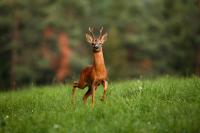
A male roe deer in hard antler. Why are male ungulate antlers and horns so large? Darwin, when proposing his theory of evolution and sexual selection, suggested that the size of male ungulate antlers and horns may reflect male individual quality, and thereby be used by conspecifics as an honest signal of male sexual vigor, health, strength, hierarchical status, or ability to fight.
Researchers from five institutes in three European countries (CEFS-INRA, LBBE- CNRS , and ONCFS in France; Grimsö Wildlife Research Station in Sweden; and CEES in Norway) have investigated this issue for the first time in a territorial ungulate species, the European roe deer. In a paper published in the April issue of the American Naturalist, Cécile Vanpé and collaborators analyzed long-term data on antler size from three contrasting populations of roe deer (Bogesund in Sweden, and Chizé and Trois Fontaines in France). They demonstrated that antler size in males is indeed an honest signal of their individual quality as assessed by age and body mass.
Jean-Michel Gaillard comments, "Our results provide evidence that antler size of male roe deer mainly reflects their age and body mass, and is more resilient to variation in environmental conditions such as climate, food resources, and density." "Body mass and age are both reliable descriptors of individual quality in most vertebrates and have been shown to affect the ability to fight and the dominance of males. Hence, by choosing their sexual partners on the basis of their large antlers, females may thus ensure that they mate with a high quality mate," says Cécile Vanpé. Petter Kjellander adds, "Males may also use antler size of rival males as a cue to assess the possibility of winning a fight in order to control and monopolize more females for reproduction." Mark Hewison concludes, "This leads to the key question of whether males with larger antlers do have greater access to females than other males." According to François Klein, Guy Van Laere, and Daniel Delorme, this study clearly indicates that antler size might be used as an indicator of individual quality on which management rules could be based.
Source : University of Chicago Press Journals
 Print Article
Print Article Mail to a Friend
Mail to a Friend
